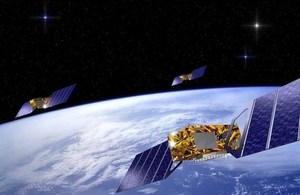Galileo
Galileo is Europe’s global navigation satellite system currently in development, owned by the European Commission (EC).

Artist's impression of Galileo satellites in orbit. Credit: ESA (J. Huart).
Galileo: Europe’s global sat nav system
The European Commission are in partnership with the European Space Agency (ESA) who are the technical design and procurement authority. Galileo’s is different from other similar systems in that it is a civil system under civil control.
Designed to be inter-operable with GPS, the US global satellite navigation system, receivers that are equipped with the right chipsets will be able to use signals from both systems to provide a more accurate and reliable global positioning service.
A range of services will be extended as the system is built up from Initial Operational Capability (IOC) to reach the Full Operational Capability (FOC) by this decade’s end.
The fully deployed Galileo system consists of 30 satellites (27 operational + 3 active spares), positioned in three circular Medium Earth Orbit (MEO) planes at an altitude of 23,000km above the Earth.
The large number of satellites together with the carefully-optimised constellation design, plus the availability of the three active spare satellites, is intended to ensure that the loss of one satellite would have no discernible effect on the user.
The first two In Orbit Validation satellites, GIOVE-A and GIOVE-B, manufactured in the UK by Surrey Satellite Technology Limited (SSTL) and Astrium Ltd, were launched in 2005 and 2008 respectively, serving to test critical Galileo technologies and safeguard the spectrum filing.
The current constellation now consists of four operational Galileo satellites, also manufactured in the UK by Astrium Ltd, launched in 2011 and 2012 which built upon previous efforts to become the operational nucleus of the full Galileo constellation. The payloads of the next set of 22 satellites are being built in Guildford by Surrey Satellite Technology Limited. This demonstrates the UK’s considerable investment in the Programme and the subsequent benefit to UK industry. Further launches are scheduled for Quarters 3 and 4, 2014.
Initially the Galileo Programme envisages three aspects of the constellation capability to be demonstrated under ‘Early Services’. It is expected that these services should be demonstrated from October 2014, then as the constellation is built-up beyond that, new services will be tested and made available to reach Full Operational Capability (FOC). These services can be found on the ESA website.
Our programmes
PRS receiver development programme
This programme hopes to secure the UK’s long-term national security interests and industrial pre-eminence in respect of Galileo PRS technologies through securing UK competitiveness and Sovereign National Security interests by ensuring that the UK retains an influential role in technologies that will drive the future PRS market.
Working closely with the Technology Strategy Board (TSB), the Satellite Applications Catapult and key industry partners, the UK Space Agency is developing a full end-to-end PRS Key Management and Distribution capability for national deployment. This will service two platforms which demonstrate the breadth of application of future PRS Technologies. The future market for PRS technology was identified under the Innovation Growth Strategy (IGS) as likely to be worth in excess of £1billion per annum in twenty years time. The UK intends to secure a significant proportion of this opportunity.
Scheduled for demonstration in March 2015, shortly after the declaration of Early Services, the UK Space Agency is actively looking for early test users to validate and demonstrate the added value of authenticated and resilient positioning in a range of applications across Government and critical infrastructure.